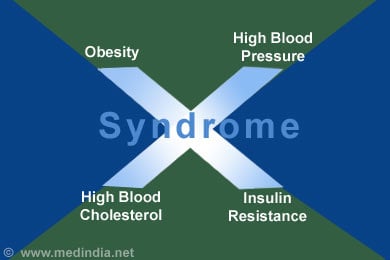- Rastogi, S. "Diet, Diabetes and You" 2012
- Strand, R.D. "What Your Doctor Dosen’t Know About Nutritional Medicine May Be Killing You" 2009
- The National Diabetes Information Clearinghouse (NDIC)
- NIH: National Institute of Diabetes and Digestive and Kidney Diseases
- American Diabetes Association
About
"Syndrome X" or “Metabolic syndrome” is a group of conditions that puts a person at risk for diabetes and heart disease. With

"Syndrome X" or “Metabolic syndrome” is a group of conditions that puts a person at risk for diabetes and heart disease. It comprises of -
- Elevated blood pressure (Hypertension)
- Elevated triglycerides
- Low HDL (good) cholesterol levels
- High LDL (bad) cholesterol levels
- Significant “uncontrolled weight gain” (central / abdominal obesity)
Insulin resistance is the most probable cause of this condition. Insulin is a hormone the body produces to help turn sugar from food into energy for the body. With insulin resistance, too much sugar builds up in the blood, setting the stage for type 2 diabetes.
“Syndrome X” in a person sets in by the following pathways.
Path 1
- Excess weight and inactivity release cytokines in the blood stream
- This causes inflammation
- Inflammation inhibits the action of insulin
- Body is unable to use insulin effectively
- The demand for insulin increases
- Body powers the pancreas to produce more insulin
- Larger amounts of insulin is shelled out to control sugar levels
- Elevated levels of insulin lead to serious health problems
- These problems constitute the very alarming stage called as “The Syndrome X” or “Metabolic Syndrome”
- The pancreas are eventually exhausted
- They fail to make enough insulin
- Blood glucose rises to “pre-diabetic levels”
- This subtle process takes 5 to 10 years
- When the pancreas are unable to keep up with the demand for insulin, blood glucose rises to levels that warrant the diagnosis of diabetes.
Path 2
- Increased frequent consumption of high glycemic index foods like white bread, white pasta, rice, potatoes
- The blood sugars rise rapidly
- This stimulates release of insulin
- When the blood sugar drops, one feels hungry again very soon
- There is an intake of another big meal or a snack and the entire process is again repeated
- After a period of time, the body becomes less and less sensitive to insulin
Once insulin resistance sets in, the process of atherosclerosis accelerates. That is why it is critical to recognize syndrome X as soon as possible and encourage lifestyle changes that correct the condition. A patient may have syndrome X many years before the actual detection of diabetes. A healthier lifestyle makes all the difference. It can reverse the condition back to normal.
Through exercise and healthful eating, the release of the hormone glucagon takes place. Glucagon has an action opposite of that of insulin. It utilizes fat, lowers blood pressure, decreases triglycerides and LDL cholesterol, and raises HDL cholesterol.





